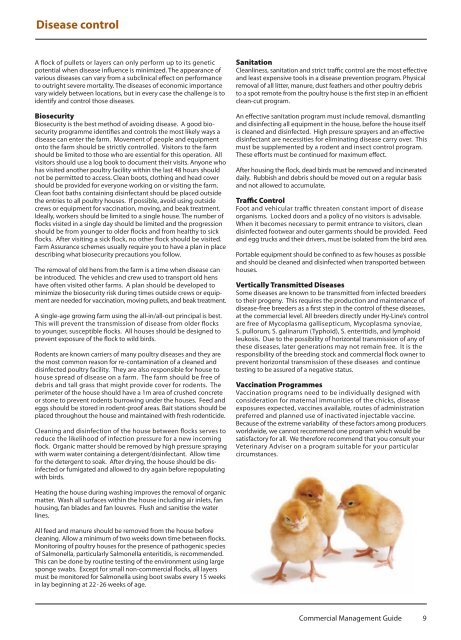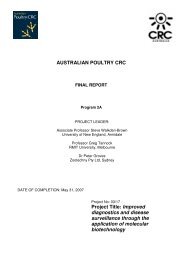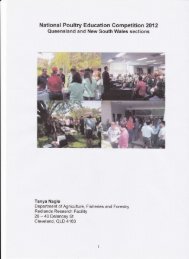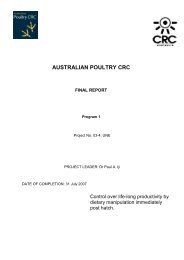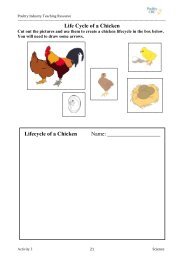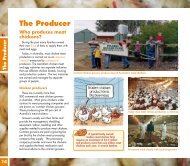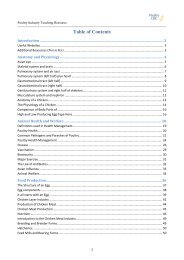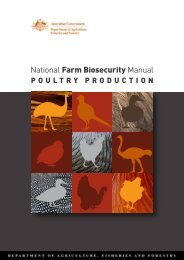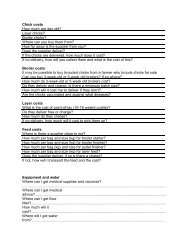Hy-Line Brown Commercial management guide - Poultry Hub
Hy-Line Brown Commercial management guide - Poultry Hub
Hy-Line Brown Commercial management guide - Poultry Hub
You also want an ePaper? Increase the reach of your titles
YUMPU automatically turns print PDFs into web optimized ePapers that Google loves.
Disease controlA flock of pullets or layers can only perform up to its geneticpotential when disease influence is minimized. The appearance ofvarious diseases can vary from a subclinical effect on performanceto outright severe mortality. The diseases of economic importancevary widely between locations, but in every case the challenge is toidentify and control those diseases.BiosecurityBiosecurity is the best method of avoiding disease. A good biosecurityprogramme identifies and controls the most likely ways adisease can enter the farm. Movement of people and equipmentonto the farm should be strictly controlled. Visitors to the farmshould be limited to those who are essential for this operation. Allvisitors should use a log book to document their visits. Anyone whohas visited another poultry facility within the last 48 hours shouldnot be permitted to access. Clean boots, clothing and head covershould be provided for everyone working on or visiting the farm.Clean foot baths containing disinfectant should be placed outsidethe entries to all poultry houses. If possible, avoid using outsidecrews or equipment for vaccination, moving, and beak treatment.Ideally, workers should be limited to a single house. The number offlocks visited in a single day should be limited and the progressionshould be from younger to older flocks and from healthy to sickflocks. After visiting a sick flock, no other flock should be visited.Farm Assurance schemes usually require you to have a plan in placedescribing what biosecurity precautions you follow.The removal of old hens from the farm is a time when disease canbe introduced. The vehicles and crew used to transport old henshave often visited other farms. A plan should be developed tominimize the biosecurity risk during times outside crews or equipmentare needed for vaccination, moving pullets, and beak treatment.A single-age growing farm using the all-in/all-out principal is best.This will prevent the transmission of disease from older flocksto younger, susceptible flocks. All houses should be designed toprevent exposure of the flock to wild birds.Rodents are known carriers of many poultry diseases and they arethe most common reason for re-contamination of a cleaned anddisinfected poultry facility. They are also responsible for house tohouse spread of disease on a farm. The farm should be free ofdebris and tall grass that might provide cover for rodents. Theperimeter of the house should have a 1m area of crushed concreteor stone to prevent rodents burrowing under the houses. Feed andeggs should be stored in rodent-proof areas. Bait stations should beplaced throughout the house and maintained with fresh rodenticide.Cleaning and disinfection of the house between flocks serves toreduce the likelihood of infection pressure for a new incomingflock. Organic matter should be removed by high pressure sprayingwith warm water containing a detergent/disinfectant. Allow timefor the detergent to soak. After drying, the house should be disinfectedor fumigated and allowed to dry again before repopulatingwith birds.SanitationCleanliness, sanitation and strict traffic control are the most effectiveand least expensive tools in a disease prevention program. Physicalremoval of all litter, manure, dust feathers and other poultry debristo a spot remote from the poultry house is the first step in an efficientclean-cut program.An effective sanitation program must include removal, dismantlingand disinfecting all equipment in the house, before the house itselfis cleaned and disinfected. High pressure sprayers and an effectivedisinfectant are necessities for eliminating disease carry over. Thismust be supplemented by a rodent and insect control program.These efforts must be continued for maximum effect.After housing the flock, dead birds must be removed and incinerateddaily. Rubbish and debris should be moved out on a regular basisand not allowed to accumulate.Traffic ControlFoot and vehicular traffic threaten constant import of diseaseorganisms. Locked doors and a policy of no visitors is advisable.When it becomes necessary to permit entrance to visitors, cleandisinfected footwear and outer garments should be provided. Feedand egg trucks and their drivers, must be isolated from the bird area.Portable equipment should be confined to as few houses as possibleand should be cleaned and disinfected when transported betweenhouses.Vertically Transmitted DiseasesSome diseases are known to be transmitted from infected breedersto their progeny. This requires the production and maintenance ofdisease-free breeders as a first step in the control of these diseases,at the commercial level. All breeders directly under <strong>Hy</strong>-<strong>Line</strong>’s controlare free of Mycoplasma gallisepticum, Mycoplasma synoviae,S. pullorum, S. galinarum (Typhoid), S. enteritidis, and lymphoidleukosis. Due to the possibility of horizontal transmission of any ofthese diseases, later generations may not remain free. It is theresponsibility of the breeding stock and commercial flock owner toprevent horizontal transmission of these diseases and continuetesting to be assured of a negative status.Vaccination ProgrammesVaccination programs need to be individually designed withconsideration for maternal immunities of the chicks, diseaseexposures expected, vaccines available, routes of administrationpreferred and planned use of inactivated injectable vaccine.Because of the extreme variability of these factors among producersworldwide, we cannot recommend one program which would besatisfactory for all. We therefore recommend that you consult yourVeterinary Adviser on a program suitable for your particularcircumstances.Heating the house during washing improves the removal of organicmatter. Wash all surfaces within the house including air inlets, fanhousing, fan blades and fan louvres. Flush and sanitise the waterlines.All feed and manure should be removed from the house beforecleaning. Allow a minimum of two weeks down time between flocks.Monitoring of poultry houses for the presence of pathogenic speciesof Salmonella, particularly Salmonella enteritidis, is recommended.This can be done by routine testing of the environment using largesponge swabs. Except for small non-commercial flocks, all layersmust be monitored for Salmonella using boot swabs every 15 weeksin lay beginning at 22-26 weeks of age.<strong>Commercial</strong> Management Guide 9


